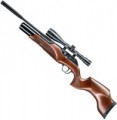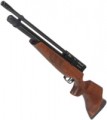Muzzle velocity
The muzzle velocity provided by the rifle - that is, the speed of the bullet as it exits the barrel.
All other things being equal, a higher bullet speed provides greater range and accuracy, and also simplifies aiming at long distances: the bullet flies along a smoother trajectory and requires fewer adjustments in height, and the influence of side winds decreases with increasing speed. On the other hand, this indicator directly affects the price of the rifle; and in some countries, legal restrictions on the ownership of pneumatic weapons are also related to the muzzle velocity of the bullet.
As for specific values, in the weakest modern rifles the initial speed does not exceed
150 m/s, and in the most powerful it can be
300 - 350 m/s or even
more(remember, the speed of sound is 330 m/s). In general, for recreational shooting at short distances, this parameter is not particularly important, and detailed recommendations for choosing pneumatics for more specific situations can be found in special sources. Let us only note that in AEG electric drives (see “Type”) the initial speed extremely rarely exceeds 150 m/s, but this is done solely for safety reasons: such “weapons” are intended for military-tactical games and initially involve shooting at people, and the high speed would be unsafe for players even with protective equipment.
It is also wor
...th considering that this indicator is not strictly defined. In any type of pneumatic it depends on the weight of the bullet (the lighter the faster); therefore, in the characteristics it is usually customary to indicate a certain average velocity for standard ammunition (usually weighing 0.5 g, in AEG - 0.2 g). In addition, in multi-compression rifles the actual speed of the bullet is determined by the degree of inflation, in gas-cylinder rifles it is determined by the ambient temperature, and in PCP models it is possible to achieve higher speeds than declared by replacing the air with a special gas (for example, helium). Nevertheless, this characteristic makes it possible to evaluate the capabilities of the rifle and compare it with other models, including those that differ in type.Type of ammunition
The type of ammunition that the rifle is designed to use.
— Bullets. In this case, a bullet is a projectile of a directional shape, with a clearly defined front and back. The specific shape of such projectiles may be different, but they all have a number of common features. Thus, any bullet with the same initial speed flies further and hits more accurately than a ball. And lead or another soft metal is usually used as a material, which gives a number of advantages. Firstly, bullets work great with rifled barrels (see "Barrel"): the edges of the bullet fit neatly into the grooves on the inner surface (many bullets are even able to slightly expand at the moment of firing, for the most dense placement in the barrel), the projectile effectively spins and stabilizes, while the wear of the rifling is minimal. Secondly, bullets flatten when hitting a more or less hard surface - this minimizes the risk of ricochets and allows the use of such ammunition even when hunting fairly large game. The only disadvantage of bullets is their higher cost than balls.
— Balls. Most models using this type of ammunition are intended for airsoft and are AEGs (see "Type") or spring-piston ("spring" in airsoft jargon) rifles. The balls in this case are plastic, large in size, which reduces the penetration ability and minimizes the likelihood of injury. Traditional air rifles for this type of ammunition are very rare. They use metal balls - usually made of steel with or without a...copper or zinc coating, less often made of lead. Such shells are very inexpensive and have good penetration, but are noticeably inferior to bullets in terms of convenience and efficiency. Firstly, the balls themselves are less accurate, they have a greater spread and lose speed faster. Secondly, the hard metal makes it difficult to use with rifled barrels, which, again, further reduces accuracy. Thirdly, due to the same hardness, steel balls often ricochet. The last two points are not relevant for the lead balls mentioned, but they are much less common than steel ones. So, in general, this type of ammunition can be recommended for recreational shooting at short distances - up to 10, less often up to 20 m.
— Lead bullets/balls. Rifles that accept both bullets and balls. For more information on each type of ammunition, see above, but here we note that the main option in this case is still bullets; balls should be considered a backup option. As a rule, such "omnivorous" rifles are supplied with separate magazines for different types of projectiles.
Magazine capacity
And in models like AEG (see “Type”) and other airsoft weapons, the capacity is indicated for the standard magazine supplied in the kit; in this case, the magazine, as a rule, is removable, and if desired, it can be replaced with another one that differs in capacity. It is worth noting here that airsoft magazines are usually divided into “bunkers” (high capacity) and “mechanics” (low capacity). Mechanas typically hold up to 150 pellets, and some of these magazines have the same capacity as real weapons. This variety is appreciated by lovers of realism and experienced players. In “bunkers,” in turn, the capacity is already hundreds, and sometimes thousands, of bullets. They are convenient for beginners and undemanding airsoft players, but a serious drawback of such magazines is noise - the balls, hanging in the main compartment of the “bunker”, turn it into a rattle, making it difficult to move covertly.
Storage capacity
Volume of the compressed air tank installed in the PCP rifle (see “Type”); if there are two tanks (see below), their total capacity is usually indicated.
A large tank allows for a greater number of shots per fill, but there is no strict dependence here: this number will also depend on the pressure in the tank, muzzle energy and some other specific factors. So in this sense, the tank capacity is purely for reference. But what it directly affects is the dimensions and weight of the weapon: a larger container will inevitably weigh more and take up more space. However, the latter drawback is often compensated for by the large length and small diameter of the reservoir - such a detail fits well into the proportions of the rifle.
As for specific volumes, they can vary up to 60 – 100 cm3 in relatively simple and inexpensive rifles up to 500 cm3 in high-end models; and if there are two tanks, their capacity can exceed 800 cm3.
Adjustable trigger
The ability to adjust the features of the trigger triggering of the rifle — first of all, the idle (before triggering) stroke of the trigger and the force on the hook. This allows you to optimally adjust the characteristics of the weapon to the personal preferences of everyone: for example, it is usually difficult for beginners to shoot with a tight trigger, but for trained shooters, a too soft hook that “falls through” under the finger may be inconvenient.

